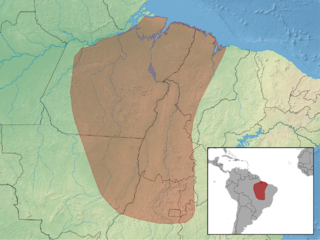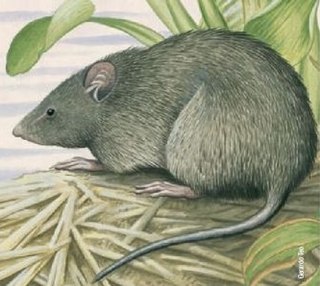
The rodent subfamily Sigmodontinae includes New World rats and mice, with at least 376 species. Many authorities include the Neotominae and Tylomyinae as part of a larger definition of Sigmodontinae. When those genera are included, the species count numbers at least 508. Their distribution includes much of the New World, but the genera are predominantly South American, such as brucies. They invaded South America from Central America as part of the Great American Interchange near the end of the Miocene, about 5 million years ago. Sigmodontines proceeded to diversify explosively in the formerly isolated continent. They inhabit many of the same ecological niches that the Murinae occupy in the Old World.

Akodontini is the second most speciose rodent tribe of the subfamily Sigmodontinae. It includes at least 106 living species in 19 genera and is distributed mainly in the southern half of South America, with only two genera extending into Guyana (Podoxymys) and Venezuela (Necromys). It also includes genera previously placed in tribe Scapteromyini. The following genera are now generally recognized:

The New World rats and mice are a group of related rodents found in North and South America. They are extremely diverse in appearance and ecology, ranging from the tiny Baiomys to the large Kunsia. They represent one of the few examples of muroid rodents in North America, and the only example of muroid rodents to have made it into South America.
The short-tailed spiny-rat or Huallaga spiny rat, is a spiny rat species found in Bolivia, Brazil, Colombia, Ecuador and Peru.

The Guyenne spiny-rat or Cayenne spiny rat, is a spiny rat species found in Brazil, Colombia, French Guiana, Guyana, Suriname and Venezuela.
The stiff-spine spiny-rat or Tefe spiny rat, is a spiny rat species found in Brazil and Colombia.
Goeldi's spiny-rat is a spiny rat species found in Brazil.

Robert's spiny-rat or Para spiny rat, is a spiny rat species found in Brazil. This species is named after the collector Alphonso Robert, who collected the holotype of this species in 1901.

The Napo spiny rat is a spiny rat species found in Brazil, Colombia, Ecuador, Peru and Venezuela.

The woolly giant rat is a species of large burrowing rodent native to South America. No subspecies are currently recognised. It is the only member of the genus Kunsia.

Lundomys molitor, also known as Lund's amphibious rat or the greater marsh rat, is a semiaquatic rat species from southeastern South America.

Pseudoryzomys simplex, also known as the Brazilian false rice rat or false oryzomys, is a species of rodent in the family Cricetidae from south-central South America. It is found in lowland palm savanna and thorn scrub habitats. It is a medium-sized species, weighing about 50 grams (1.8 oz), with gray–brown fur, long and narrow hindfeet, and a tail that is about as long as the head and body. The IUCN has assessed its conservation status as being of least concern, although almost nothing is known about its diet or reproduction.

Proechimys is a genus of South American spiny rats of the family Echimyidae. All species of the genus are terrestrial. In the lowland Neotropical forests, Proechimys rodents are often the most abundant non-volant mammals. They are recognizable by reason of their elongated heads and long rostra, large and erect ears, narrow and long hind feet, and tails always shorter than head-and-body lengths. The dorsal pelage comprises a mixture of expanded, varyingly stiffened spines — hence the vernacular name of spiny rats — and soft hairs.
Irenomys tarsalis, also known as the Chilean climbing mouse, Chilean tree mouse, or long-footed irenomys, is a rodent found in Chile, from about 36° to 46°S, and in adjacent Argentina, mainly in forests. It is a large, long-tailed, soft-furred mouse characterized by grooved upper incisors and specialized molars with transverse ridges, divided by deep valleys, which are connected by a transverse ridge along the midline of the molars.

The fossorial giant rat is a species of rodent in the family Cricetidae. It is found in Argentina and Brazil but was determined extinct following a recent assessment of the conservation status of Sigmodontine rodents. Its natural habitat is assumed to be dry savanna, but there have been no ecological details reported.

Oryzomyini is a tribe of rodents in the subfamily Sigmodontinae of the family Cricetidae. It includes about 120 species in about thirty genera, distributed from the eastern United States to the southernmost parts of South America, including many offshore islands. It is part of the clade Oryzomyalia, which includes most of the South American Sigmodontinae.
The Argentine swamp rat is a semiaquatic rodent species from South America. It is found in northeastern Argentina and Paraguay, where it lives in freshwater marshes and along the southern coast of the Río de la Plata estuary, as well as in woodland. It is characterized by having stiff hairs on its otherwise naked tail, which are believed to help the animal swim. S. aquaticus is similar in build to members of the genus Rattus. "[It] has a relatively larger head, a stouter body, larger feet, and a relatively longer tail." The pelage along its back is "long and glossy" varying from brown to dark brown. It can have a grayish wash in some individuals. "The sides have a yellowish cast." The pelage in the abdominal region is typically an off white color. The forefeet are large for use in swimming and digging. All digits, including the pollex are equipped with a claw. Its karyotype has 2n = 32.
Reigomys primigenus is an extinct oryzomyine rodent known from Pleistocene deposits in Tarija Department, southeastern Bolivia. It is known from a number of isolated jaws and molars which show that its molars were almost identical to those of the living Lundomys. On the other hand, the animal possesses a number of derived traits of the palate which document a closer relationship to living Holochilus, the genus of South American marsh rats, and for this reason it was placed in the genus Holochilus when it was first described in 1996. The subsequent discoveries of Noronhomys and Carletonomys, which may be more closely related to extant Holochilus than H. primigenus is, have cast its placement in Holochilus into doubt, and it was ultimately made the type species of a separate genus, Reigomys.

Abrotrichini, also known as the Andean clade or southern Andean clade, is a tribe of rodents in the subfamily Sigmodontinae. It includes about fifteen species in four genera, distributed in South America from southern Peru to southernmost South America, including the Patagonian steppes. The earliest known fossils are from the Pliocene of Argentina.
Bibimys chacoensis is a species of small rodent of the family Cricetidae living in the north-central part of Southern Cone of South America. The common name of this species is Chaco crimson-nosed rat. It is one of the three species currently recognized under the genus Bibimys.











